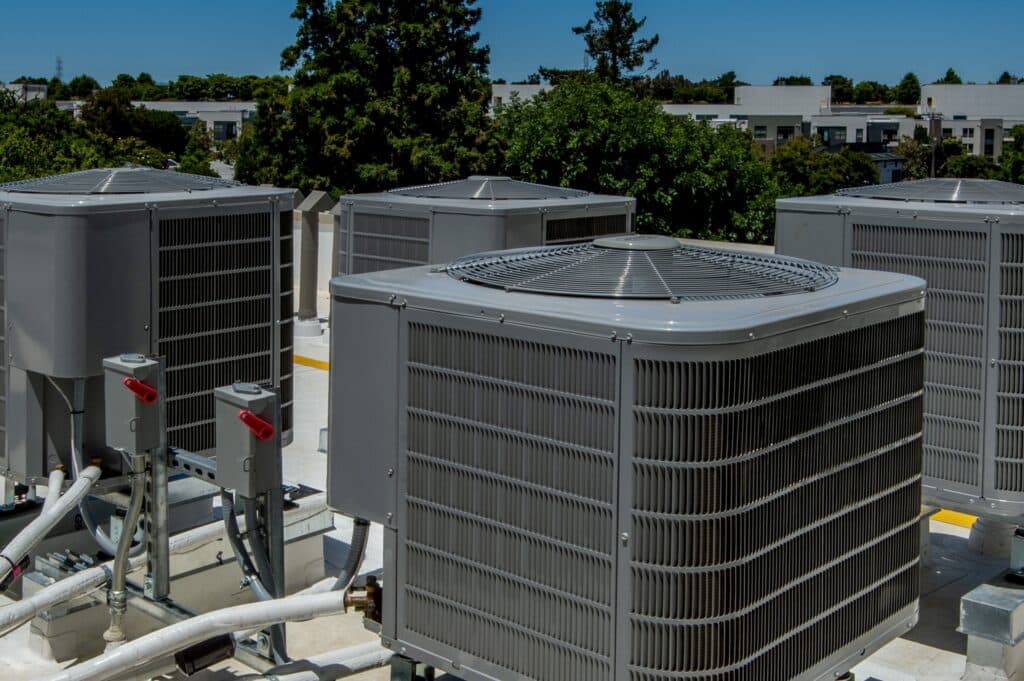
Top Humidity Control Strategies in Commercial HVAC Systems
Have you ever wondered why humidity control is crucial in commercial HVAC systems?
Maintaining the right humidity levels can make or break the comfort and efficiency of your space. Let’s explore why.
Humidity plays a vital role in the overall environment of commercial buildings. Too much moisture can lead to problems like mold growth, material damage, and discomfort for occupants.
On the other hand, too little moisture can cause dry skin, respiratory issues, and static electricity. Proper humidity control helps maintain a balance, ensuring a comfortable and healthy indoor climate.
Key Concepts in Humidity Control
Understanding humidity control begins with grasping some key concepts. These concepts help us monitor and maintain ideal humidity levels in commercial spaces.
Relative Humidity (RH)
Relative Humidity (RH) is the amount of moisture in the air compared to what the air can hold at a specific temperature. It’s expressed as a percentage. For example, if the RH is 50%, the air holds half the moisture it can at that temperature. Ideal RH levels for commercial spaces usually range between 40% and 60%.
Dew Point
The dew point is the temperature at which air becomes saturated with moisture and water begins to condense. Knowing the dew point helps in predicting when condensation will occur. This is crucial in preventing mold growth and material damage in commercial buildings.
Absolute Humidity
Absolute humidity measures the total water vapor in the air, regardless of temperature. It’s expressed in grams of water vapor per cubic meter of air (g/m³). While less commonly used than RH, absolute humidity provides a precise measure of moisture content in the air.
Common Issues Caused by Improper Humidity Levels
Managing humidity in commercial spaces is crucial. When levels are off, various problems can arise, affecting both the building and its occupants.
Mold and Mildew Growth
Excessive humidity creates an ideal environment for mold and mildew. These fungi thrive in damp conditions, spreading quickly across surfaces. Mold not only damages materials like wood and drywall but also poses serious health risks.
Occupants may experience respiratory issues, allergic reactions, and other health problems due to mold exposure. Regular monitoring of humidity levels can help prevent these issues.
Material Deterioration
Materials in commercial buildings are highly susceptible to humidity fluctuations. High humidity can cause wood to warp, paint to peel, and metals to corrode. Conversely, low humidity can lead to cracking and drying out of materials like wood and paper.
This deterioration not only affects the aesthetics of a building but can also lead to costly repairs and maintenance.
Health Implications for Occupants
Improper humidity levels can significantly impact the health and comfort of building occupants. High humidity can lead to increased growth of dust mites and mold, which are common allergens. It can also cause discomfort, making the air feel sticky and warm.
Low humidity can result in dry skin, irritated eyes, and respiratory issues. Maintaining balanced humidity levels helps ensure a healthy and comfortable environment for everyone.
Essential Tools for Humidity Control
Effective humidity control in commercial HVAC systems requires the right tools. Here are some essential devices to maintain optimal humidity levels.
Hygrometers
A hygrometer is a device that measures the moisture content in the air, or humidity. It is an essential tool for monitoring and maintaining the desired humidity levels in commercial spaces.
There are various types of hygrometers, including digital and analog models, each offering different levels of precision and functionality. Using hygrometers helps you keep track of humidity levels and make necessary adjustments to avoid problems.
Humidifiers
Humidifiers add moisture to the air, increasing humidity levels. They are crucial in areas with low humidity, especially during winter months when heating systems can dry out indoor air.
There are several types of humidifiers, including central humidifiers integrated with HVAC systems and portable units for specific areas. Using humidifiers helps maintain comfort and prevent issues caused by dry air.
Dehumidifiers
Dehumidifiers remove excess moisture from the air, reducing humidity levels. They are essential in environments prone to high humidity, such as basements, kitchens, and certain commercial spaces.
Dehumidifiers come in various sizes and capacities, from small portable units to large industrial systems. They help prevent mold growth, material deterioration, and discomfort due to excessive humidity.
HVAC Integrated Humidity Sensors
Modern HVAC systems often come with integrated humidity sensors. These sensors continuously monitor humidity levels and automatically adjust the system to maintain optimal conditions.
They provide precise control over the indoor climate, ensuring a balanced and comfortable environment. Integrated humidity sensors also help improve energy efficiency by optimizing HVAC system operation.

Smart Thermostats
Smart thermostats offer advanced features for humidity control. They allow for remote monitoring and adjustments, giving you greater control over your indoor environment.
Many smart thermostats come with built-in humidity sensors and can be programmed to maintain specific humidity levels. They also provide insights and alerts, helping you manage humidity more effectively and efficiently.
Portable vs. Whole-House Humidity Control Systems
Choosing between portable and whole-house humidity control systems depends on various factors. Both options have their advantages and limitations, so understanding these can help in making an informed decision.
Advantages and Limitations of Portable Systems
Portable humidity control systems are convenient and flexible. They are ideal for targeted humidity control in specific areas or rooms. Here are some key benefits:
- Flexibility: Portable units can be moved to different locations as needed.
- Cost-Effective: They are generally less expensive than whole-house systems.
- Ease of Use: Portable units are easy to install and operate.
However, portable systems also have limitations:
- Limited Coverage: They are suitable for small to medium-sized areas but may not be effective for large spaces.
- Maintenance: Portable units require regular maintenance, including cleaning and refilling water reservoirs for humidifiers.
- Noise: Some portable units can be noisy, which may be disruptive in quiet environments.
Benefits of Whole-House Systems
Whole-house humidity control systems are integrated into the HVAC system, providing comprehensive humidity management throughout the entire building. Here are the primary benefits:
- Uniform Coverage: These systems ensure consistent humidity levels across all areas of the building.
- Convenience: Whole-house systems operate automatically, requiring minimal intervention.
- Energy Efficiency: Integrated systems can be more energy-efficient, as they optimize the HVAC operation for balanced humidity control.
- Low Maintenance: These systems often require less frequent maintenance compared to multiple portable units.
Despite their advantages, whole-house systems also have considerations:
- Higher Initial Cost: Installation of whole-house systems can be expensive.
- Complex Installation: They require professional installation and may involve modifications to the existing HVAC system.
- Less Flexibility: Unlike portable units, whole-house systems cannot be easily moved or reconfigured.
Strategies for Effective Humidity Control
Maintaining proper humidity levels in commercial spaces requires a multi-faceted approach. Here are some key strategies for effective humidity control.
Maintaining Proper Ventilation
Proper ventilation is crucial for controlling humidity. It helps remove excess moisture from the air and prevents the buildup of humidity. Here are some steps to ensure proper ventilation:
- Install Exhaust Fans: Use exhaust fans in areas prone to high humidity, such as kitchens and bathrooms.
- Regularly Clean Air Ducts: Ensure that air ducts are clean and free of obstructions to promote good airflow.
- Use Ventilation Systems: Incorporate mechanical ventilation systems to provide a steady exchange of indoor and outdoor air.
Regular HVAC Maintenance
Regular maintenance of your HVAC system is essential for optimal humidity control. Maintenance tasks include:
- Change Filters: Replace HVAC filters regularly to ensure efficient airflow.
- Inspect and Clean Coils: Clean the evaporator and condenser coils to maintain the system’s efficiency.
- Check Refrigerant Levels: Ensure the refrigerant levels are adequate to prevent humidity issues caused by improper cooling.
Optimal Use of Humidifiers and Dehumidifiers
Using humidifiers and dehumidifiers effectively can help maintain ideal humidity levels. Here’s how to optimize their use:
- Set Appropriate Levels: Adjust humidifiers and dehumidifiers to maintain humidity levels between 40% and 60%.
- Position Correctly: Place units in central locations for even distribution of moisture or dehumidification.
- Monitor Regularly: Use hygrometers to monitor humidity levels and adjust settings as needed.
Techniques for Reducing Humidity
High humidity can cause numerous issues in commercial spaces. Implementing effective techniques to reduce humidity is crucial for maintaining a healthy and comfortable environment.
Using Dehumidifiers Effectively
Dehumidifiers are essential tools for reducing indoor humidity levels. To use them effectively:
- Choose the Right Size: Select a dehumidifier that matches the size of the space. Larger areas may require industrial-sized units.
- Proper Placement: Place the dehumidifier in a central location for optimal performance. Ensure it’s in an area with good airflow.
- Regular Maintenance: Empty the water reservoir frequently and clean the filter to maintain efficiency.
Enhancing Ventilation Systems
Improving ventilation can significantly reduce humidity levels. Here are some ways to enhance ventilation:
- Install Ventilation Fans: Use fans in high-humidity areas such as kitchens and bathrooms to expel moist air.
- Use Air Exchangers: These devices can help replace humid indoor air with fresh outdoor air.
- Open Windows and Doors: When weather permits, opening windows and doors can improve airflow and reduce humidity.
Implementing Moisture Barriers
Moisture barriers are materials that prevent moisture from entering your building. They are particularly useful in areas prone to dampness. Here’s how to implement them:
- Use Vapor Barriers: Install vapor barriers in walls, floors, and ceilings to prevent moisture intrusion.
- Seal Cracks and Gaps: Ensure that all cracks and gaps in the building’s envelope are sealed to prevent moisture ingress.
- Waterproof Basements: Apply waterproofing solutions to basement walls and floors to prevent moisture buildup.
Techniques for Increasing Humidity
In some commercial spaces, especially in dry climates or during winter, increasing humidity can be essential for comfort and health. Here are effective techniques to raise humidity levels.
Utilizing Humidifiers
Humidifiers add moisture to the air, helping maintain ideal humidity levels. To use them effectively:
- Select the Right Type: Choose between portable units for specific areas and whole-house humidifiers for comprehensive coverage.
- Maintain Proper Settings: Set the humidifier to maintain humidity levels between 40% and 60%.
- Regular Maintenance: Clean and refill the humidifier regularly to ensure it functions efficiently.
Incorporating Water Features
Water features can naturally increase humidity levels in a space. Here’s how to use them:
- Indoor Fountains: Install indoor fountains in common areas to add moisture to the air.
- Aquariums: Place aquariums in offices or lobbies to boost humidity and create a calming atmosphere.
- Plants: Add indoor plants that release moisture through transpiration, helping increase humidity.
Adjusting HVAC Settings
Modifying HVAC settings can help increase indoor humidity:
- Lower Heating Temperatures: Reducing the heating temperature can help maintain higher humidity levels.
- Use Humidity Control Settings: Utilize built-in humidity control features in modern HVAC systems to regulate moisture levels.
- Install Humidity Sensors: Equip your HVAC system with humidity sensors that can automatically adjust settings to maintain optimal humidity levels.
Integrating Smart Technology in Humidity Control
Incorporating smart technology in humidity control can significantly enhance the efficiency and convenience of managing indoor environments. Here’s how smart tech can revolutionize humidity control in commercial spaces.
Benefits of Smart Thermostats
Smart thermostats offer advanced features for precise humidity control. Key benefits include:
- Remote Access: Control humidity levels from anywhere using a smartphone or tablet.
- Energy Efficiency: Smart thermostats optimize HVAC system performance, reducing energy consumption and costs.
- Customizable Settings: Set schedules and preferences to maintain ideal humidity levels throughout the day.
Remote Monitoring and Adjustments
Smart technology allows for real-time monitoring and adjustments, ensuring optimal humidity levels at all times. Here’s how:
- Real-Time Alerts: Receive notifications if humidity levels fall outside the desired range.
- Automatic Adjustments: Smart systems can automatically adjust settings based on current humidity readings.
- Data Tracking: Monitor trends and analyze data to make informed decisions about humidity control.
Impact of Climate on Humidity Control
Climate plays a significant role in determining the humidity control strategies for commercial spaces. Seasonal variations and regional differences must be considered to maintain optimal indoor environments.
Seasonal Variations
Seasonal changes can dramatically affect indoor humidity levels. Here’s how to manage these variations:
- Winter: Cold air holds less moisture, leading to lower indoor humidity. Use humidifiers to add moisture and maintain comfort.
- Summer: Warm air can hold more moisture, resulting in higher indoor humidity. Use dehumidifiers and increase ventilation to keep levels in check.
- Spring and Fall: These transitional seasons may require adjusting HVAC settings and using both humidifiers and dehumidifiers as needed to balance humidity levels.
Regional Considerations (Focus on Euless, TX)
Euless, TX, experiences a humid subtropical climate, characterized by hot summers and mild winters. Here’s how to manage humidity control in this region:
- Summer: High humidity levels are common in summer. Dehumidifiers and enhanced ventilation are essential to prevent excess moisture and ensure comfort.
- Winter: While winters are mild, indoor heating can reduce humidity levels. Use humidifiers to maintain balance and prevent dryness.
- Year-Round Monitoring: Due to the fluctuating climate, continuous monitoring and adjustments are crucial. Smart thermostats and integrated HVAC systems can help maintain optimal humidity levels throughout the year.
Customizing Humidity Control for Specific Commercial Applications
Different commercial spaces have unique humidity control needs. Here’s how to tailor humidity control strategies for various settings.
Office Buildings
Maintaining optimal humidity levels in office buildings is essential for comfort and productivity.
- Balanced Humidity: Keep humidity between 40% and 60% to ensure a comfortable working environment.
- Air Quality: Use air purifiers and plants to improve air quality and humidity balance.
- Smart Thermostats: Implement smart thermostats for precise control and monitoring.
Warehouses
Warehouses often have large open spaces that require specific humidity control measures.
- Industrial Dehumidifiers: Use high-capacity dehumidifiers to manage humidity in large areas.
- Ventilation Systems: Enhance ventilation to prevent moisture buildup and maintain air quality.
- Moisture Barriers: Install moisture barriers to protect stored goods from humidity damage.
Retail Spaces
Retail spaces need consistent humidity control to protect products and ensure customer comfort.
- Central HVAC Systems: Use integrated HVAC systems with humidity control features.
- Product Protection: Maintain humidity levels to prevent damage to products, especially those sensitive to moisture.
- Customer Comfort: Ensure the environment is comfortable for shoppers, promoting longer visits and increased sales.

FAQs on Humidity Control in Commercial HVAC Systems
-
What are the ideal indoor humidity levels for commercial spaces?
The ideal indoor humidity levels for commercial spaces typically range between 40% and 60%. This range ensures comfort for occupants and helps prevent issues such as mold growth and material deterioration.
-
What are the signs of high or low humidity in a building?
Signs of high humidity include condensation on windows, musty odors, and visible mold or mildew. Signs of low humidity include dry skin, static electricity, and cracking or shrinking of wooden materials.
-
How does HVAC humidity control benefit allergy sufferers?
Proper humidity control reduces the presence of allergens such as dust mites and mold spores. Maintaining optimal humidity levels helps minimize these allergens, providing relief for allergy sufferers.
-
Do I need both humidifiers and dehumidifiers for my commercial space?
Yes, having both humidifiers and dehumidifiers allows you to adjust humidity levels as needed throughout the year. Humidifiers add moisture during dry conditions, while dehumidifiers remove excess moisture during humid conditions.
-
What are the cost considerations for implementing humidity control in a commercial HVAC system?
The cost varies based on the type and size of the system, as well as the specific needs of your commercial space. Portable units are generally less expensive but may require multiple units for larger spaces. Whole-house systems involve higher initial costs but offer comprehensive and efficient humidity control.


